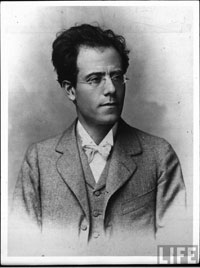Variations on a Theme
November 1, 2011
Version française...
Flash version here.
Looking for a
change from your go-to classics? Take a cue from the LSM team as we
recommend listening alternatives to the usual masterworks.
 The Masterwork: The Masterwork:
Mahler’s Symphony No. 5
Austrian composer and conductor Gustav Mahler (1860-1911) is best known
for his symphonic works and songs. He enjoyed widespread popularity
in his lifetime and many of his compositions are canons in the Western
classical music tradition. Mahler’s legacy experienced a period of
interruption during the Nazi regime when Hitler banned his music and
that of all Jewish composers. His Fifth Symphony was one of the first
works to be resurrected in German-speaking countries after World War
II.
Although it is in
five movements, the Fifth stands apart from its predecessors as Mahler’s
most conventional symphony to that point. He saw it essentially as a
four-movement work, with the first and second movements as one. Moreover,
it ends with a rondo, like many classical symphonies. Musical subjects
unify and control the character of the piece. The first movement’s
opening funeral march, played by solo trumpet, reflects a sombre, serious
character on the symphony, but is also used to transition into the next
theme, which is more emotionally charged and dramatic with the indication
“Leidenschaftlich” or passionately.
The rough character
of the thematic material seemed to be a struggle even for Mahler; he
laboured through several revisions of the work. The global structure
of the Fifth Symphony is characterized by its uniform model and the
overall tonal shift from C# minor to D major. This is underlined by
dense orchestral polyphony and is prominently outlined by the almost
naturalistic melodic themes that define this work. Audrey Sproule
René Bricault’s
essential Fifth :
Mahler: Symphony no. 5
Royal Concertgebouw Orchestra/Riccardo Chailly
Decca 458860 (1998)
It is no mean feat to balance Mahler’s large orchestral works successfully,
while not losing focus on their emotional expression in the midst of
such expansive forms. This is particularly true of the Fifth, whose
characteristics are so well defined from one movement to the next (funeral
drama, love, heroism...). Preferring the digital recording for its precise
rendering of instrumental colours (another essential aspect of Mahler’s
work), I keep returning to the passionately lucid Chailly and the Concertgebouw.
Frédéric cardin
recommends…
Hans Rott (1858-1884)
Symphony
No. 5
Years written: 1878-1880
Similarities: Epic gestures and complex harmonic language
combined in a decisively pre-late-romantic discourse. The third
movement of the Symphony is amazingly reminiscent of Mahler. He was
undoubtedly an influence. Mahler wrote: “His Symphony [in E major]
makes him... the Founder of the New Symphony as I see it.”
Differences: His premature passing (25 years old in 1884) stopped
him from going through with his musical ideas. His late-romanticism
is more instinctive than truly thought through. However, it is eminently
exciting to listen to.
Essential listening:
Hans Rott: Symphony No. 1; Orchestral Works
Munich Radio Orchestra/Sebastian Weigle
Arte Nova Classics ANO 577480
Éric Champagne
recommends…
Ralph Vaughan Williams
Symphony
No. 8 in D minor
Years written: 1953-1955
Similarities: For the celebrated Adagietto from his Fifth
Symphony, Mahler used but half of the orchestra, keeping only the strings.
Following a similar logic, Vaughan Williams’ Eighth Symphony has a
movement just for strings—the popular Cavatina—as well as its counterpart
for winds, his equally famous Scherzo alla marcia.
Differences: The scale and scope of Mahler’s psychological
work go far beyond the intentions of Vaughan Williams, whose short symphony
(27 minutes) is relatively classic and unpretentious. The work nevertheless
deserves attention for its rich orchestral colours and charm, which
keep coming back.
Essential listening:
Vaughan Williams: Symphonies Nos. 2 and 8
BBC Symphony Orchestra/Andrew Davis
Teldec 4509-90858-2 (1994)
Paul E. Eobinson
recommends…
Benjamin Britten (1913-1976)
Death
in Venice
Year written: 1973
Similarities: The Adagietto movement from the Mahler Fifth was
used as the basis for the soundtrack of Visconti’s 1971 film “Death
in Venice.” The music then became widely popular in its own right.
Britten’s opera “Death in Venice” was premiered two years later.
Differences: The source for both Visconti and Britten was Thomas
Mann’s 1912 novella “Death in Venice”, about a dying man’s fascination
with a young boy. Britten’s opera, written when he himself was in
declining health, brings the Mann story to life with music of extraordinary
transparency and imagination. No doubt Britten was drawn to the story
because of his own homosexuality. It was Britten’s last opera and
one of the great works of the Twentieth Century.
Essential listening:
Britten: Death in Venice
Decca 425 669-2 (1990)
Catch Mahler’s
Fifth Live:
» New York Philharmonic/Gilbert, November 4. Montréal – www.osm.ca
» Orchestre symphonique de Gatineau, March 31, 2012. Gatineau –
www.osgatineau.ca
Translation:
Lynn Travers
Version française... | 

